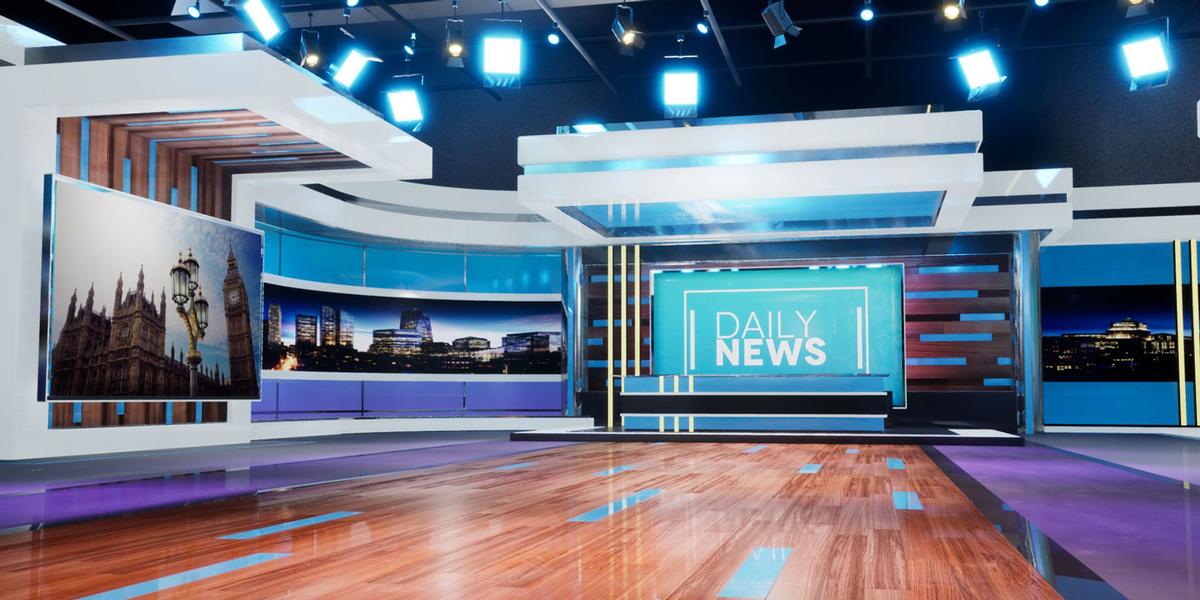
It's happened: The realistic virtual sets and advanced news graphics that have been wowing TV viewers for years have become accepted elements of broadcast production.
“It’s no longer a gimmick,” said Ray Ratliff, Vizrt’s Product Evangelist, XR. “Broadcasters and media producers are leveraging these technologies to help them tell their stories, expanding the depth and richness of their stories in new and powerful ways.”
Better Quality, Easier to Use
Just because virtual sets and advanced news graphics have come of age doesn't mean that these technologies are standing still. In fact, advances in both technologies explain why they continue to impress viewers and news producers alike.

“The improvements in tracking technology for virtual sets have been a game-changer,” said Mike Paquin, Ross Video’s Senior Product Manager, Virtual Solutions, “These systems are now incredibly precise and reliable, which means they require less maintenance and can be used daily without the need for constant recalibration.
"The improvement in control systems is also significant: in the past, there were standalone control systems which required a dedicated operator, but with technology like Voyager and Lucid, the control side can be easily integrated with existing workflows, eliminating the need for dedicated operators and extensive training.”
Advanced news graphics have also become easier to use, accelerating the adoption of virtual sets and augmented reality (AR) in TV news production.

“One factor driving this trend has been increasing simplicity in use for day-to-day graphics,” said Aldo Campisi, Chyron’s Vice President for Latin America, Caribbean, Spain & Portugal. “We’ve focused on simplifying and deskilling daily use of virtual sets and/or augmented reality, even enabling our customers to extend the CAMIO newsroom automation workflow they use for traditional graphics into the world of virtual sets and virtual graphics,” he said. “With this functionality, producers can use a familiar tool set to build graphics in 3D space, in augmented reality, and in virtual sets all while maintaining data visualization functionality.”
Thanks to the integration of artificial intelligence (AI) into virtual set and news graphics systems, achieving “real-time photorealism is easier and more cost-effective than ever before,” said Ratliff. At the same time, the ability to format these effects into templates is simplifying and speeding up the production process “without impacting staffing requirements.”
The Impact
Collectively, advances in virtual sets and news graphics are allowing broadcasters to explain stories to their viewers in new and visually exciting ways.
For instance, when Thailand’s Amarin TV wanted to explain the progress of an election during a results broadcast, “they visualized the candidates as runners on a race track,” said David Dowling, Chief Revenue Officer with Pixotope Technologies. “Depending on how well they were doing or how big their numbers were, the graphics showed their positions on the track, plus whether they were still fresh or tired, or about to give up the ghost.”
Meanwhile, when Iceland’s RUV TV wanted to explain the latest volcano that had erupted on that island nation, “they incorporated an AR volcano onto their news set,” Dowling said. “It was a story-telling element that really helped their presenters explain what was going on.”
Across the TV broadcast industry, “we see customers using immersive graphics to put their presenters in the middle of the action,” said Ratliff. “Broadcasters place their people in fully virtual environments, bringing more significant presence and context to their stories, helping viewers understand the content better. We’ve seen incredible examples of this globally on a variety of coverage whether it's elections, sports or other major news.”
By its very nature, a 3D virtual set offers more spaces that may be digitally branded than with simpler 2D graphics."
Aldo Campisi, Chyron
“Graphics are now truly telling the story in an immersive way, and they're not just being used in virtual sets, where talent is in front of a green screen,” Campisi added. “Visual storytelling is also being enhanced with augmented graphics. The presenter might be standing in front of a true LED video wall with graphics that are brought into extended reality, creating an immersive experience that empowers the newsroom team to demonstrate, visualize, and story tell with much greater detail and emphasis.”
What’s Coming Next
As impressive as virtual sets and news graphics are today, they are likely to wow viewers even more in the years to come. At the same time, the trend in these technologies is to make them less obvious to the viewer, rather than more.
“I think that photorealism is something that people are crying out for and I can certainly see that trend having an impact on the way in which graphics are presented,” Dowling said. “Even if it's just a lower third or a bug, the look will be as close to real life as possible.”
Meanwhile, the technologies that have revolutionized the look of TV news appear destined to break out of this niche.
“At Chyron, we’re increasingly being asked for solutions that help our customers commercialize their productions,” said Campisi. “By its very nature, a 3D virtual set offers more spaces that may be digitally branded than with simpler 2D graphics. Looking ahead, we can see how advanced skeletal tracking and visualization — to the point that it’s highly representative and realistic — could be translated across sports and entertainment.
“For example, a match targeting a younger demographic could feature all the well-known athletes on a team stylized to look like characters from a popular animated series or an epic space opera,” Campisi added. “In other words, properties and brands could be marketed and monetized in remarkable new ways to realize exponential returns.”
Advances in GPUs, AI tools, and decreasing LED prices are now blurring the lines between virtual and actual reality, according to Campisi.
“These innovations will enable hyper-realistic, immersive sets and interactive presentations, enhanced by AR and MR integration. Cloud-based flexibility, real-time automation, and lifelike virtual characters will revolutionize newsroom graphics, pushing the boundaries of visual media.”







